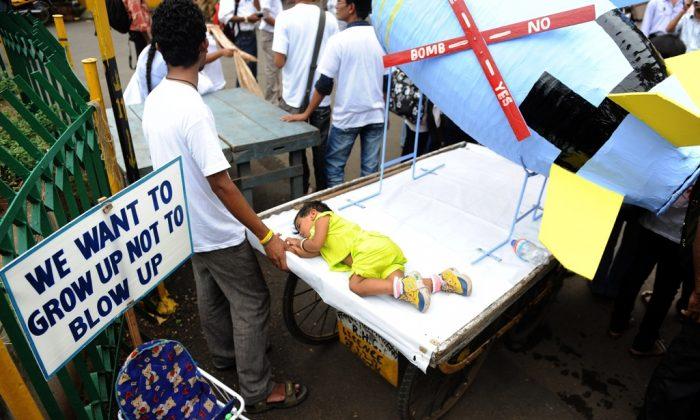China, India, and Pakistan gradually expanded their nuclear arsenal, adding more weapons to their nuclear stockpiles last year, a global security watchdog reported.
According to the Stockholm International Peace Research Institute’s (SIPRI) 2013 report, India and Pakistan’s estimated nuclear warheads increased at the beginning of this year as both nations added 10 warheads each to their arsenals, while China’s warheads count also gradually increased from 240 to 250 over the course of the year.
Currently there are five legally recognized nuclear weapon states as per the 1968 Non-Proliferation Treaty (NPT) viz. China, France, Russia, the UK, and the United States. The report said that out of these only “China has long been the least transparent about its nuclear forces.”
The Chinese regime hasn’t provided any official information about the size and composition of its nuclear forces and weapon production complex.
China is among the key arms exporters in the world; the communist country along with India and a few other nations, recently abstained from signing the landmark Arms Trade Treaty, which regulates the multibillion-dollar global arms trade.
India and Pakistan are in fact nuclear weapon states outside the NPT, which makes it difficult to find reliable information on the operational status of their nuclear arsenals and capabilities. Both countries continue to develop their nuclear weapon stockpiles, and deploy new types of ballistic and cruise missile delivery systems, the report said.
“However, the situation in South Asia is not locked in a classic arms race per se,” Shannon N. Kile, a senior researcher for SIPRI, told the Epoch times via email.
“India’s nuclear force development and procurement decision-making is increasingly driven by perceived concerns about China’s strategic capabilities and intentions,” said Kile, who is currently working as head of the nuclear weapons project of the SIPRI arms control and non-proliferation program.
Kile said that Pakistan is focusing on nuclear weapons designed to address the imbalance in conventional military forces between it and India, while China is gradually expanding its small nuclear arsenal as part of a long-term modernization program to reinforce its land-based, road-mobile, and sea-based nuclear deterrent.
“Beijing’s concerns about maintaining a credible second-strike capability are closely linked to advances in missile defenses and non-nuclear strategic weapon systems, in particular by the United States,” he added.
At the start of 2013, eight states possessed approximately 4,400 operational nuclear weapons, 2,000 of which are kept in a state of high operational alert, the report said. If all nuclear warheads are counted, the eight NPT parties, along with India, Pakistan, and Israel together possess approximately 17,270 nuclear weapons.
The report also estimated the world military expenditure in 2012 to be around $1,756 billion, representing 2.5 percent of global gross domestic product (GDP) or $249 for each person in the world.
“Unfortunately, there is virtually no publicly available information about how much China and Pakistan [spend] on developing and maintaining their nuclear arsenals,” Kile said. “The situation is somewhat better with respect to India but even here SIPRI is unable to provide a rough estimate of nuclear weapon-related spending.”
Asia has witnessed a significant number of bilateral tensions, unresolved conflicts periodically leading to deadly incidents, and disputes over land and sea borders.
During the past few years, China, India, and Pakistan have shown a steady tendency toward nuclear proliferation. The tensions in the region might be more manageable if these nations worked to enhance cooperation through partnership, mutual reassurance, and transparency.




